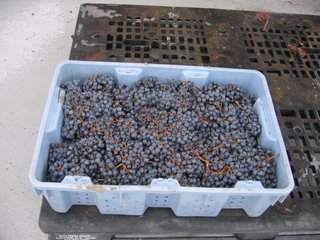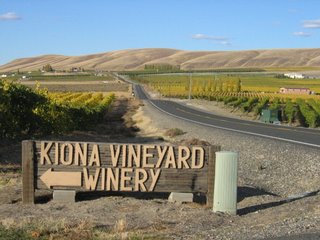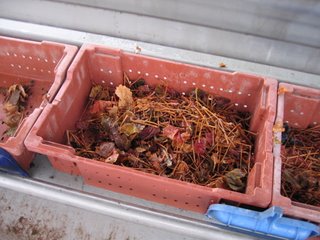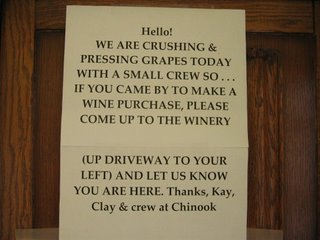
Hurray! We had our last crush today. This is a photo of the last box of the 2006 Harvest/Crush season. Yes, the very last one. Many of the surrounding wineries are also winding down their crush season. I thought we were done this season with the Cabernet Sauvignon. But, we got a small load of Lemberger from Kiona. These will become the "Lola Red" house wine for Tom Douglas's Lola Restaurant in Seattle. Shhhhh! Don't tell Cab Sauv, but I think I have a mad crush on Lemberger. When I first encountered this wine. I admit I turned my nose up at it. The name. The unfortunate, un-sexy name. It just didn't do anything for me. Lucky for me, this red grape varietal from Germany-Austria flourishes in Washington and Oregon and there are a number of great expressions of this wine. Kiona is where I first fell in love.
 Kiona Wines describe their Lemberger Red as, " rich red wine aromas, nuances of Cabernet or Merlot are present, but with a spicy intriguing background not easy to identify at first tasting. Wonderful and well-defined aromas of blackberries and cloves emerge with more experience. This mildly tannic wine sports great structure, with a velvet mouth feel. American and French oak is evident in the long smooth finish." Indeed! As an eating grape, it is delicious and sweet. What I like about Lemberger is its deep color and earthy fruitfulness. Kay makes a gorgeous Lemberger Dry Rose which expresses the very thing I love. I had a fun time following that grape to wine. Here I am yeasting the Lemberger grapes for the Lola Red.
Kiona Wines describe their Lemberger Red as, " rich red wine aromas, nuances of Cabernet or Merlot are present, but with a spicy intriguing background not easy to identify at first tasting. Wonderful and well-defined aromas of blackberries and cloves emerge with more experience. This mildly tannic wine sports great structure, with a velvet mouth feel. American and French oak is evident in the long smooth finish." Indeed! As an eating grape, it is delicious and sweet. What I like about Lemberger is its deep color and earthy fruitfulness. Kay makes a gorgeous Lemberger Dry Rose which expresses the very thing I love. I had a fun time following that grape to wine. Here I am yeasting the Lemberger grapes for the Lola Red. Thurston Wolfe also makes a nice Lemberger which sells out very quickly. Although Lemberger is not widely planted with only about a 100 acres planted in the state, it was the favored grape of Dr. Walter Clore "Father of Washington Wine." Kiona Vineyard was the first to plant it commercially in 1976 and release the first commercial vintage(1980) in 1983.
Thurston Wolfe also makes a nice Lemberger which sells out very quickly. Although Lemberger is not widely planted with only about a 100 acres planted in the state, it was the favored grape of Dr. Walter Clore "Father of Washington Wine." Kiona Vineyard was the first to plant it commercially in 1976 and release the first commercial vintage(1980) in 1983.  But don't feel bad if you've never heard of it. Lemberger is also known by other names: Blaufrankisch in Austria, Franconia in Friuli and Kekfrankos in Hungary. Some wineries are marketing the wine as Blau Franc, Blue Frank or Blue Burgunder. These sound promising. Every wine has it's day. When that day comes, I'm sure that Dr. Walt will be smiling down at us. What a long way Washington Wines have come since the early days of the WSU Experimental Station in Prosser, WA.
But don't feel bad if you've never heard of it. Lemberger is also known by other names: Blaufrankisch in Austria, Franconia in Friuli and Kekfrankos in Hungary. Some wineries are marketing the wine as Blau Franc, Blue Frank or Blue Burgunder. These sound promising. Every wine has it's day. When that day comes, I'm sure that Dr. Walt will be smiling down at us. What a long way Washington Wines have come since the early days of the WSU Experimental Station in Prosser, WA.

